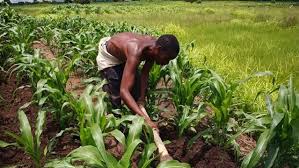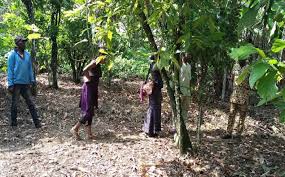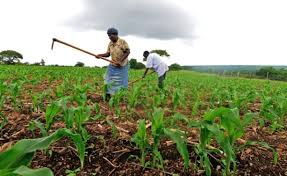In this article, attention is focused on the prospects and problems of agriculture. The prospects of agriculture are discussed through its importance to the economy of Nigeria, followed by the major problems affecting agricultural development in the country.
Read Also: How To Grow Apple Trees
Major Importance of Agriculture to the Nigerian Economy

The importance of agriculture refers to the role it plays in the survival of individuals and the development of the nation’s economy. Below are some of the major contributions of agriculture to Nigeria:
1. Provision of Food for Human Consumption
Agriculture remains the most important source of food for Nigerians and the global population. Without food, nations face starvation, reduced life expectancy, and increased vulnerability to diseases.
This essential role of agriculture continues to support life. Over the years, various methods such as experimentation, breeding, and improved farming techniques have been used to enhance both the quality and quantity of food production.
2. Provision of Feed for Livestock
Agriculture is responsible for the cultivation of crops, many of which are used as feed for domestic animals. These animals convert feed into valuable animal proteins such as meat, eggs, and fish for human nutrition. Protein is a crucial part of a balanced diet.
In addition to concentrate feeds, agriculture produces pasture and forage crops, reducing the need for ruminant animals to travel long distances in search of grasses. This limits dependence on wild animals for protein sources.
3. Employment Opportunities in the Agricultural Sector
Agriculture is a key source of employment globally, especially in less developed nations. Despite growth in other sectors, agriculture remains the leading employer in Nigeria.
Approximately 70% of the labor force is engaged in agriculture, and about 90% of the rural population relies heavily on it. Women and children participate directly or indirectly in the cultivation and processing of groundnut, palm oil, cocoa, cotton, and rubber. Many others are employed in agro-based industries.
4. Supply of Raw Materials for Industries
Agriculture plays a vital role in supplying raw materials to manufacturing industries. In Nigeria, sustained efforts have been made to develop local industries, and agriculture is crucial to meeting their raw material needs. Examples of agricultural raw materials and their industrial uses include:
i. Palm oil for soap production
ii. Oil seeds for edible oils and oil cakes
iii. Oil cakes and seeds for livestock feed production
iv. Sugarcane for refined sugar
v. Tobacco leaf for cigarette manufacturing
vi. Cotton lint for textile production
vii. Cocoa for beverages
viii. Ripe fruits for canned fruit processing
ix. Raw rubber for tyres and tubes
x. Wood pulp for paper manufacturing
5. Foreign Exchange Earnings from Agricultural Exports
Agricultural exports serve as a major source of foreign exchange earnings, which are used to finance imports and development projects. Historically, Nigeria depended on agricultural exports for economic growth before petroleum became dominant.
For example, in 1962, agriculture contributed about 82% of the country’s total export value. However, by 1976, during the oil boom, agriculture’s share dropped to around 4%. With increased efforts by both government and private sectors, the figure improved to about 20% by 2007.
6. Contribution of Agriculture to National Income
Income generated from agricultural activities is a major source of revenue for farmers and those involved in processing and marketing.
These individual incomes contribute to the country’s Gross Domestic Product (GDP). For instance, agriculture’s share of GDP ranged from 36.5% in 1973/74 to 24.4% in 1977/78. Despite some decline over the years, agriculture remains a significant contributor to national income.
7. Agriculture as a Tool for Rural Development
Agriculture plays a fundamental role in rural development. Through farming income, rural dwellers engage in community development and self-help projects.
Many rural areas have constructed amenities such as primary and secondary schools, boreholes, bridges, hospitals, and post offices using agricultural earnings.
Government also contributes by constructing roads and railways to transport farm produce from rural areas.
Large markets are established in agriculturally productive communities, and some villages are recognized for hosting important markets due to their agricultural output.
8. Provision of Shelter and Clothing through Agriculture
Agriculture significantly contributes to shelter and clothing. Trees from permanent crops provide timber for building and furniture making, while crops such as cotton offer lint for textile production. These materials are essential for meeting the shelter and clothing needs of the population.
Read Also: How to Grow Paw-Paw (papayas): Beginners Business Guide
Problems of Agricultural Development

Erebor (1998) identified seventeen problems facing the development of agriculture in Nigeria. These include land tenure, amenities, finance, transportation, communication facilities, processing and farm machines, government policies, marketing systems, pests and diseases, production uncertainty, farm inputs, attitudes towards farming, and environmental degradation.
Other additional problems are customs, poverty, and farmers’ organisations.
1. Problem of Land Tenure
Land tenure refers to the system of land ownership. In Nigeria, most of the land belongs to individuals or communities. This method of ownership does not encourage commercial agriculture, as land is often acquired through inheritance.
It leads to land fragmentation and sometimes results in communal clashes, causing the destruction of lives and properties. Farmers with the capital to utilize the land effectively may not belong to the land-owning group.
Even when given access, they may hesitate to invest fully, knowing the land can be reclaimed by the owner at any time. In some cases, landowners dictate what crops the landless farmers should cultivate. Population growth has increased the competing uses of land, placing further pressure on the limited land available.
2. Lack of Basic Infrastructural Amenities
Agriculture is closely linked to the rural economy. Most rural areas, where over 70% of agricultural production takes place, lack social and infrastructural amenities. These include motorable roads, electricity, health facilities, standard schools, telephone services, and clean water supply.
These facilities are essential to improve the living standards of rural farmers and boost agricultural productivity.
Good roads facilitate the movement of workers and farm produce to urban centers. Clean water reduces waterborne diseases, while health facilities ensure timely treatment of illnesses, keeping farmers and their families healthy and productive.
The lack of such amenities leads to rural-urban migration, reducing the farming population in villages. Currently, most remaining rural farmers in Nigeria are above 40 years, as the youth migrate to urban areas in search of jobs.
3. Poor Financing of Agriculture
Most agricultural activities in Nigeria are handled by peasant farmers. One major challenge facing rural farmers is lack of finance. Very few farmers are able to access loans from credit institutions due to several reasons:
i. Farmers are generally poor,
ii. Many cannot provide the collateral required for loans, and
iii. Some cannot afford the high interest rates charged by financial institutions.
As a result, many farmers still operate at a subsistence level. Farmers need both production and consumption credits to lift themselves out of poverty.
4. Poor Transportation Facilities
Road transportation is the major means of transport in Nigeria, especially in rural areas. Transportation here includes both the road conditions and the availability of vehicles.
Rural roads are often rough, bad, and only passable during the dry season. Vehicles are scarce and often lack spare parts. These poor transportation conditions result in high costs of transporting farm produce to urban centers and increase perishability.
Middlemen exploit this situation by raising prices or hoarding products to create artificial scarcity.
5. Poor Communication
Communication tools such as radio, television, telephone, telex, and fax are essential for agricultural development. They are used to pass vital agricultural information to farmers.
However, communication infrastructure in Nigeria is still poor. Most villages lack access to television and telephone services, and where available, most farmers cannot afford them.
6. Lack of Storage Facilities
Rural farmers mostly rely on traditional storage methods such as barns, cribs, and rhumbus, which are inadequate for preserving large quantities of produce or storing fresh products.
Modern storage facilities like silos, cold rooms, and refrigerators are scarce in rural areas. This leads to perishability, pest attacks, and diseases. Other problems include reduced quality and quantity of produce, market glut during harvest, and food shortages outside harvest periods.
7. Lack of Processing Facilities
Processing of farm products is essential for agricultural development. However, rural areas lack processing machines and spare parts.
Even when available, they are often too expensive for local farmers. Some machines are technical and require skilled operators. Maintenance is difficult and costly due to a lack of technicians and spare parts.
8. Illiteracy Level of the Farmers
Many Nigerian farmers are illiterate and lack knowledge of agricultural practices. They are unaware of innovations and how to apply them. A farmer who knows about fertilizer but not how to use it gains little advantage.
According to Erebor (1998), illiteracy causes:
i. Reluctance to change,
ii. Superstitious beliefs,
iii. Suspicion of innovation,
iv. Unscientific thinking, and
v. Uncooperative and hostile behavior.
9. Poor Extension Services
Extension services help farmers access modern agricultural information from government agencies. These services are weak in Nigeria. The number of extension workers is too small for the farming population.
Most lack transportation to reach farmers, and many are unwilling to live in rural areas. Those who do are poorly paid. These issues contribute to the poor performance of extension services.
10. Poor Farm Tools and Machinery
Most Nigerian farmers still use crude implements, keeping them at the subsistence level. Some available modern tools are unsuitable for local soil conditions.
Others are costly, require skilled operators, or cannot be used on fragmented lands. These issues force farmers to rely on manual labor and outdated tools, leading to low yields, shorter farmer lifespans, time wastage, and low income.
11. Unstable Government Policies and Programmes
Governments often launch agricultural programmes or policies such as the Land Use Decree, Operation Feed the Nation, Marketing Boards, Green Revolution, Farm Settlement Scheme, and the Directorate of Food, Roads and Rural Infrastructure.
Many of these initiatives are discontinued once the initiators leave office. Some policies even harm farmers, such as food imports that reduce demand for local produce. Inconsistent policies, like subsidy grants and removals, also hinder agricultural progress.
12. Poor Marketing System
A strong marketing system is vital for agricultural development. In Nigeria, marketing is inefficient. Many rural roads are not motorable year-round, and available vehicles are often in poor condition.
These factors limit trade volume and increase transport time. Limited competition forces farmers to sell their products at low prices. The removal of agricultural marketing boards has left farmers vulnerable to exploitation by middlemen.
13. Problem of Pests and Diseases
Pests and diseases significantly affect agricultural output. Their impacts include:
i. Increased production costs,
ii. Reduced quality of produce,
iii. Decreased farmer income, and
iv. Lower production quantity.
14. Production Uncertainty
Unlike industrial production, agriculture depends heavily on weather. Crops need rainfall, and any irregularity drought, flood, or excessive sunshine affects yield. Farmers rely on natural conditions, and adverse weather leads to low productivity.
15. Wrong Attitude to Farming
Many people view farming as a job for the poor. Youths avoid it, preferring white-collar jobs in cities. Those who stay in farming are often looked down on.
This negative perception means farming is left to older people who may resist new innovations, slowing agricultural development.
16. Problem of Environmental Degradation
Environmental issues like pollution, erosion, bush burning, and deforestation hinder agriculture. Oil pollution in producing areas damages crops.
Erosion, caused by rain or wind, depletes soil and raises production costs. Bush burning can destroy crops and reduce soil nutrients. Deforestation affects soil microorganisms vital for soil fertility.
17. Customs of the People
Traditional beliefs influence agriculture. Some communities prohibit the production or consumption of certain foods for superstitious reasons. For example, some believe that children who eat eggs will become thieves.
Customs can also dictate what crops or animals are acceptable. Such practices slow the acceptance of innovation.
18. Poverty Level of Farmers
Agricultural success demands significant capital. Many problems listed above stem from farmer poverty. Most farmers are trapped in a cycle: low output leads to low income, which results in low savings, low investment, and continued low output.
Commercial farming requires land, improved seeds and breeds, and costly modern equipment. Poverty prevents farmers from making these investments.
19. Poor Farmers’ Organisations
Farmer organisations are established to support agricultural activities. These include marketing cooperatives, thrift and credit societies, and group farming cooperatives.
However, due to administrative and financial challenges, many of these organisations are ineffective
Do you have any questions, suggestions, or contributions? If so, please feel free to use the comment box below to share your thoughts. We also encourage you to kindly share this information with others who might benefit from it. Since we can’t reach everyone at once, we truly appreciate your help in spreading the word. Thank you so much for your support and for sharing!

